October 2016
STAR Newsletter
October 2016 edition
Contents:- Jet-like correlations with direct-γ and π0
- Hard Probes & INT Workshop Recaps
- From the Spokesperson
- iTPC Project Update
A note from the editor: as a collaboration-wide communication tool, this newsletter is set up to allow comments (subject to moderation against abuse), and all STAR Collaborators are welcome to do so! Please keep in mind that some content (including all comments) may be considered internal to the Collaboration and only accessible when logged into Drupal. Documentation is available here.
Jet-like correlations with direct-γ and π0
(Nihar Sahoo & Saskia Mioduszewski - Texas A&M University)
The STAR experiment recently published “Jet-like correlations with direct-photon and neutral-pion triggers at √sNN = 200 GeV” in Physics Letters B 760 (2016) 689.
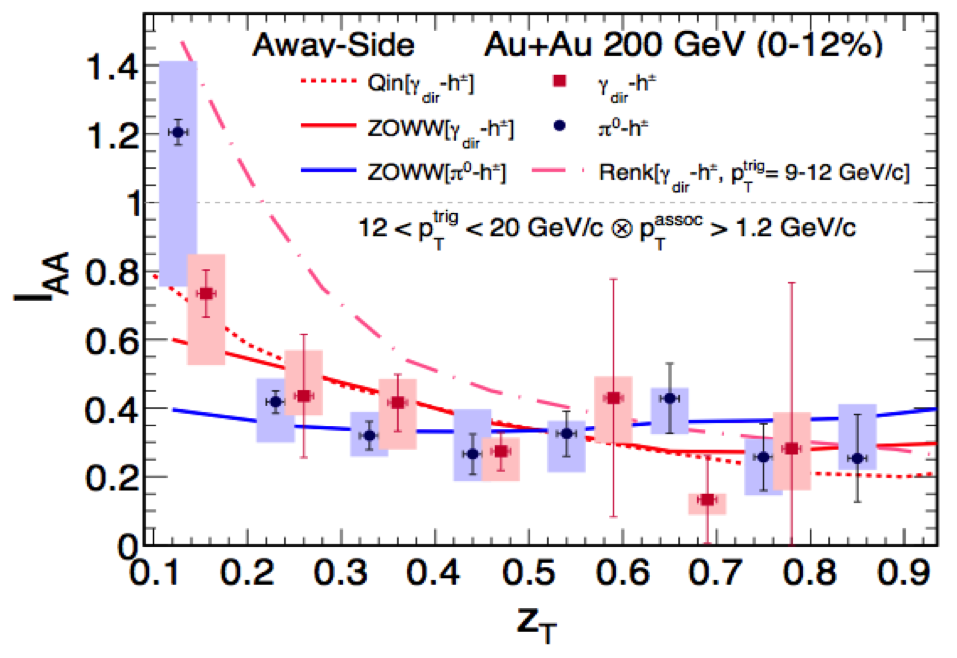
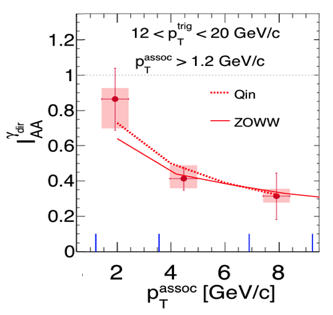
Left: The IAA for direct-photon and neutral-pion triggers are plotted as a function of zT. The points for IAA for direct-photon triggers are shifted by +0.03 in zT for visibility. Right: IAA for direct-photon triggers as a function of transverse momentum of the jet-like associated hadrons. The vertical lines represent statistical errors and the vertical extent of the boxes represents systematic errors. The curves represent different energy-loss models.
It is also compelling to compare the suppression of jet-like yields on the recoil side of direct-photon triggers with the suppression of jet-like yields on the recoil side of neutral-pion (or hadron) triggers. Differences in the suppression are expected from two effects. 1) There is a trigger bias for neutral pions (since they are themselves subject to medium interaction and energy loss) to be from the surface of the medium, maximizing the path length of the recoil parton through the medium; whereas direct-photon triggers can originate from anywhere within the medium (since the direct-photon mean-free-path is much larger than the size of the medium). 2) The recoil side of direct-photon triggers is dominated by quark jets, while the recoil of neutral-pion triggers can be either quark or gluon jets. Both of these effects naively should result in a larger suppression, on average, for the recoil jet-like yields associated with neutral-pion triggers than those associated with direct-photon triggers. One would expect to get information about both the path-length and the color-factor dependence of parton energy loss through the comparison.
The IAA for direct-photon (red) and neutral-pion (blue) triggers are plotted as a function of zT (=pTassoc/pTtrig or the ratio of transverse momentum carried by the away-side hadron relative to that of the trigger) in the left panel of the figure. The results suggest that for jet-like associated hadrons, with transverse momentum greater than 1.2 GeV/c, the suppression factor is similar for direct-photon and neutral-pion triggers, within measurement uncertainties. The expected effects due to differences in path length and color-factor are not observed, within uncertainties, within our kinematic range. There is a hint of less suppression (for both types of triggers) at low zT, but this effect is more significant when IAA is plotted as a function of the transverse momentum of the jet-like associated hadron's pTassoc (shown in the right panel of the figure).
In contrast to these results, PHENIX (Phys. Rev. Lett. 111 (2013) 032301) has measured an enhancement in jet-like yields (IAA>1), at large angles, for zT=0.1-0.25. In the PHENIX measurement, the trigger photon has transverse momentum 5-9 GeV/c, and the associated hadrons have transverse momentum as low as 0.5 GeV/c (compared to the 1.2 GeV/c lower cut in the STAR measurement). Our measurement, in comparison with the PHENIX result, has led to the important conclusion that the modified fragmentation function is not a universal function of zT.
Hard Probes & INT Workshop Recaps
(Helen Caines - Yale)
September and October involved lots of travel for STAR with many collaborators traveling to Wuhan or Seattle, or in some cases both, to speak at Hard Probes 2016 or take part in the INT-16-3 Program more familiarly known as “Exploring the QCD Phase Diagram through Energy Scans”.
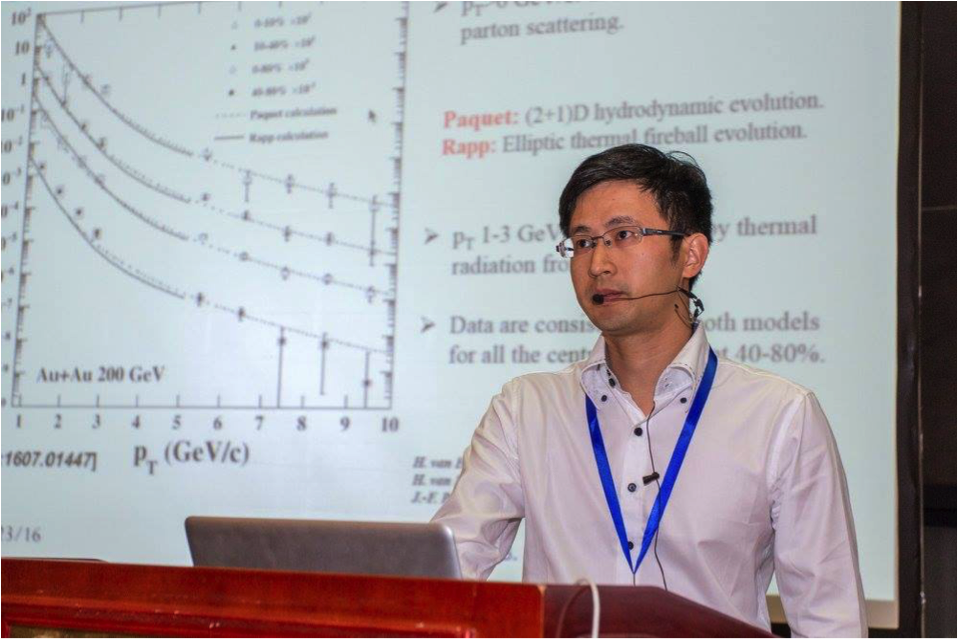


Left-to-right: Bingchu Huang, Alex Schmah, and Zebo Tang giving plenary presentations at Hard Probes 2016.
Hard Probes
The 8th International Conference on Hard and Electromagnetic Probes of High-energy Nuclear Collisions (Hard Probes 2016) took place at the East Lake International Conference Center, Wuhan, China with Peter Jacobs, Feng Liu, and Hua Pei members of the Local Organizing Committee. That's more than 24 hours of traveling one way if your setting off point is RHIC!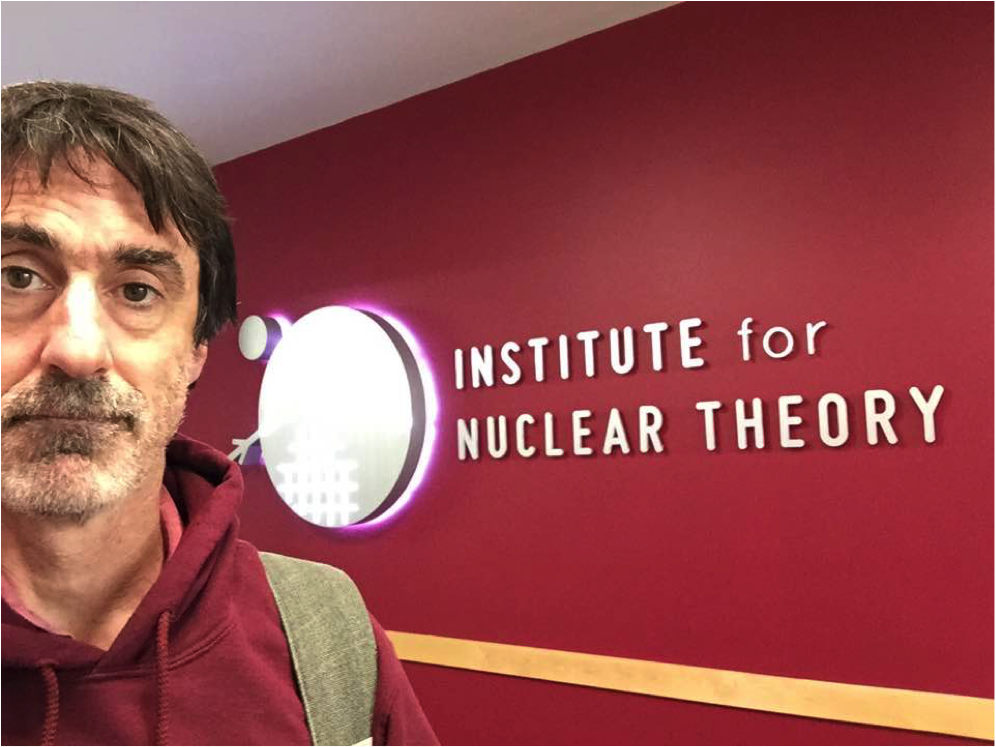
Mike Lisa at INT-16-3.
We were also well represented in the plenary sessions and student lectures with 6 speakers who are STAR collaborations presenting on topics from high pT correlations to heavy flavor and quarkonia.
Next Hard Probes will be in Aix-les-Bains, France in the fall of 2018. Finally congratulations to Frank Geurts and Christina Markert who will be members of the local organizing committee in 2020 after their bid to host the 10th edition of Hard Probes in Austin, Texas was accepted.
“Exploring the QCD Phase Diagram through Energy Scans”
Mike Lisa and Paul Sorensen were the two experimentalists on the organizing committee of this 4 week program at the Institute of Nuclear Theory in Seattle Washington. The program aimed to evaluate what we currently know about the QCD phase diagram and address how the data to be collected at the BES-II at RHIC and low energy running planned other facilities can best increase our understanding of the phases of strongly interacting matter. STAR was well represented at this workshop giving 9 presentations. As you might expect much of the discussion focused on the interpretation of proposed and existing correlation and fluctuation measurements. However, the theorists also emphasized the need for the experiments to publish the more basic details, such as the pT and rapidity distributions of as many identified hadrons as possible.From the Spokesperson
(Zhangbu Xu - Spokesperson)
Dear STAR Collaborators:
We are approaching Run 17! C-AD has worked out with BNL management and DOE an official RHIC schedule for FY17, available here.
The schedule calls for 24 cryo-weeks of operation as requested by STAR, starting from January 23rd. Experimental operation stops around June 23rd followed by ~2 weeks of Coherent electron Cooling (CeC) commissioning. Please arrange the on-call experts and detector maintenances, software readiness, and sign-up for shifts according to a Run 17 from January 24th (Tuesday) to June 27th (Tuesday), 2017.
In the last two months, we have had quite a busy schedule with all the maintenance work at the STAR Experimental Hall, productions, reviews, analyses, and conferences.
DOE has conducted an iTPC Technical, Cost, Schedule, and Management review in Germantown on September 13th-14th, 2016 (more in the iTPC Project Update below). We are following up with a review of MWPC production at Shandong University on December 3rd-4th, 2016.
Jamie Dunlop has convened a task force to assess and resolve any apparent discrepancy between STAR and PHENIX direct virtual photon results after we have submitted a STAR paper (available as 1607.01447). Thanks to Frank Geurts, Lijuan Ruan, Saskia Mioduszewski, and Wei Xie for participating in this effort together with a few PHENIX collaborators.
I have requested a collaboration committee to look into the proposals for east side installation for Run 17 and beyond. The general strategy is to help the proponents and the collaboration implement projects that will serve the best interests to the collaboration as a whole and provide guidance to me as to what are the expectations in terms of outcome, costs, and potential issues. Thanks to Joern Putschke (chair), Bill Llope, Declan Keane, Ken Barish, Saskia Mioduszewski, Evan Finch, Jiangyong Jia, Takashi Sako, Thomas Ullrich, and Bob Soja for taking on this task.
Congratulations go to the collaboration for great shows at several conferences in the last two months (ISMD, Hard Probes, INPC, DNP), just to mention a couple of exciting results released: Run 13 W-boson spin asymmetry, and jet zg (a promising measure of the gluon splitting function) in Au+Au. In the last two months, we have submitted two papers: dijet imbalance in Au+Au collisions, and dijet ALL and cross-section in p+p collisions; and we have released two new papers for collaboration review: harmonic decomposition of three-particle azimuthal correlation, and coherent diffractive photoproduction of the ρ meson.
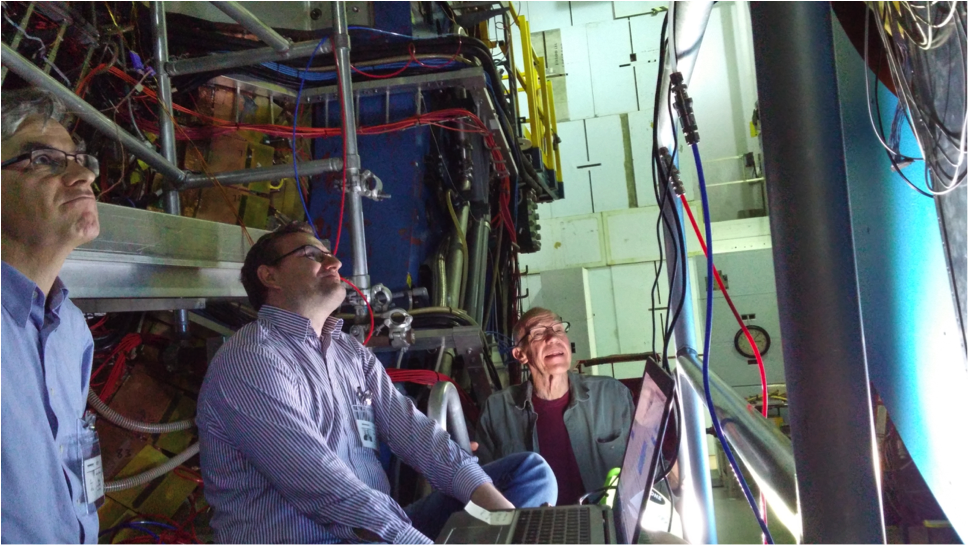

We have initiated a couple of joint projects: with the CBM Collaboration on an endcap TOF, and with the RHICf Collaboration on a very forward π0 spectrometer. These projects are coming to life! The left picture above shows collaborators Norbert Herrmann and Ingo Deppner from Heidelberg and Geary Eppley from Rice inspecting a newly mounted prototype eTOF module at the east poletip two weeks ago. The right picture aboove shows the RHICf group testing the RHICf detector at the lab room in the BNL Physics Department building. An enthusiastic group of collaborators have renewed their effort in realizing a complete forward upgrade package in response to the PAC recommendation for “a potential (polarized) p+p and/or p+A program before 2023”. A regular meeting to write a proposal for the STAR forward upgrade has been on-going every Tuesday at 10-11 a.m. (BNL time). Thanks to Elke Aschenauer and all those involved for continuing with the effort in the face of adversity.
iTPC Project Update
(Flemming Videbaek - Upgrades Leader)
The iTPC project was approved in February to move ahead and has made significant progress, but has honestly also had some difficulties. The strongbacks that are the aluminum frames that hold the pad plane and the Multi Wire Proportional Chamber wire planes were fabricated on time in June. Our difficulties have been with the production of the pad planes. A qualified vendor was identified during preproduction, but when it came to the prototypes the company has had real difficulties in getting them produced and we were delayed multiple times. The full production is now in progress and should be delivered in early December. The Shandong University group has made good progress on developing assembly techniques and testing procedures. On the electronics front we have the first few FEE cards with the prototype ALICE SAMPA chips that provide amplification, digitization, and zero-suppression. The plan, which is on track, is to install two FEEs and a newly developed RDO (for just those FEEs) on the STAR TPC in January for testing with beam.
The iTPC project had a DOE Technical, Cost, Schedule, and Management review at Germantown in mid-September. The presentations can be found here. The review report is not yet available for release, but the project got valuable advice as well as some homework as a result of the recommendations. We will also have a review of the assembly procedures and test for the MWPCs at Shandong University, Jinan, China on December 3rd and 4th. The overall schedule is tight and problems have been encountered, but good progress is being made.
Previous Edition: August 2016
Groups:
- Printer-friendly version
- Login or register to post comments
